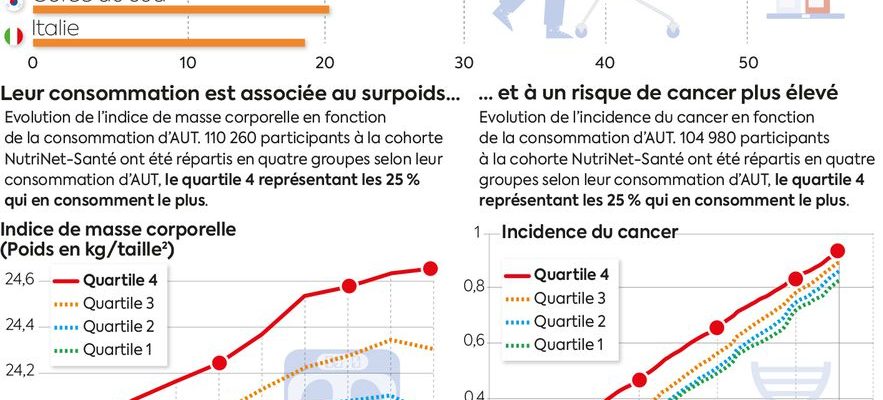Bad for health and for the figure, addictive, also harmful for the planet: over the course of scientific studies, ultra-processed foods appear increasingly problematic. Recent publications in major scientific journals point out the possible links between these foods and numerous diseases – obesity, type 2 diabetes, cardiovascular conditions, inflammatory bowel pathologies, depression… But what are we talking about? Sliced bread, biscuits, chips and other prepared meals rich in additives, with an unstructured matrix, which no longer have much to do with the raw foods from which they come. It is less easy than it seems to recognize them, because they are also found among foods classified “A” by the Nutri-Score, but also among organic or low-fat products. A short guide to finding your way around, in five questions.
How to recognize an ultra-processed food?
Not all industrial products are necessarily ultra-processed. Granola without added sugar, couscous or polenta, pasta, canned fruit, vegetables or fish are certainly processed, but not ultra-processed because their production does not involve any profound modification of the food. base or the addition of cosmetic additives, to make the product more attractive.
“If you take frozen lasagna, some will be considered ultra-processed (AUT), and others not,” notes Pierre Slamich, co-founder ofOpen food facts. This application provides information on the Nutri-Score of food products (for their nutritional qualities), but also their degree of processing with the Nova classification, developed by Brazilian scientists and commonly used by nutrition researchers. The term “Nova 4” indicates that the food is ultra-processed.
Otherwise, just look at the ingredient list. The mention of processes which profoundly change the food matrix (extrusion cooking, pre-frying, etc.) is certainly not obligatory, but many ingredients are considered markers of ultratransformation (modified starches, fructose-glucose syrup, maltodextrin, gluten, flavorings, colorings, emulsifiers, sweeteners, etc.). If a food contains one or more products with a barbaric name, which one would not find in one’s kitchen, then it is certainly ultra-processed.
Is there a quantity that should not be exceeded?
Experts struggle to answer this question precisely. “There is a very strong demand for benchmarks, but in nutrition, it is obviously excessive consumption that poses a problem. It’s a bit like with products that are too fatty, too sweet or too salty: we are not saying that “We must eliminate them, but rather we must reduce their share in our diet as much as possible”, summarizes Professor Serge Hercberg, professor emeritus of nutrition and former president of the National Nutrition and Health Program.
Studies having established a correlation between the consumption of these products and effects on health (obesity, cardiovascular diseases, type 2 diabetes, etc.) do not make it possible to establish thresholds beyond which the risk would increase: “All that what we can say is that the more we eat, the more harmful the effects are, adds Professor Hercberg. It is therefore mainly a question of raising consumer awareness. Because, good news, nutritionists also assure that it is never too late to start eating better: there will always be a health benefit.
Organic or vegetarian, is it safer?
The primary purpose of organic is to guarantee agriculture without pesticides. Although its specifications only allow a limited number of additives, this does not prevent certain “organic” products from being ultra-processed. So these chocolate breakfast cereals containing glucose syrup, or this mayonnaise whose recipe includes an acidifier, a thickener and flavorings.
© / Art Press
Products intended for vegetarians, often organic, generally turn out to be ultra-processed. This is particularly the case for substitutes for animal products, such as “steaks” or plant-based “milk”. The first are certainly made from legumes, but most also contain texturizers as well as emulsifying agents. And it’s even worse for almond or soy-based drinks. “They are not made to be transformed into ‘milk’. It is necessary to add emulsifiers and thickeners to obtain this milky texture which characterizes them”, notes the biologist Benoit Chassaing, who studies the effect of these additives on the microbiota intestinal.
What do you think of low-fat products?
The majority of ultra-processed foods also turn out to be too fatty, too sweet or too salty. However, products low in fat or sugar are not necessarily better, because many are… ultra-processed. “This is a category that we must be wary of. By removing fat from a food, we lose texture. So manufacturers will add texturizing agents, such as mono and diglycerides of fatty acids or carboxymethylcellulose , or other emulsifiers to find the creamy side”, underlines Professor Mathilde Touvier, research director at Inserm. But fortunately, there are exceptions: “You have to look carefully at the labels because you also find 0% yogurts made only with milk and lactic ferments,” she emphasizes.
Sugar-free products contain sweeteners. However, these synthetic molecules appear less and less harmless. Various studies by Mathilde Touvier’s team on the Nutrinet-Santé cohort have shown an association between the consumption of certain of these “fake sugars” and an increased risk of type 2 diabetes, cardiovascular disease or cancer. This summer, the World Health Organization’s International Agency for Research on Cancer classified aspartame as “possibly carcinogenic to humans.”
Is the Nutri-Score good advice?
The Nutri-Score was designed to provide information on the nutritional qualities of foods, namely their content of nutrients to limit (saturated fatty acids, sugars, salt) and to promote (fiber, proteins, fruits, vegetables and legumes, etc.) . “Ultra-processing and nutritional composition are dimensions that overlap but are not completely correlated,” recognizes Professor Serge Hercberg, the designer of the 5-color logo. Highly processed products, such as breakfast cereals, can be ranked well by the Nutri-Score. Conversely, minimally processed products, such as grape juice or cheese, are misclassified because they are too sweet or too fatty.
The promoters of Nutri-Score are now proposing to complete it, by adding a black frame to the logo appearing on products considered ultra-processed. “A study shows that this would be completely understandable,” underlines Serge Hercberg. But, while the battle to make Nutri-Score compulsory is still not over, this new fight promises to be even more Homeric.
.
